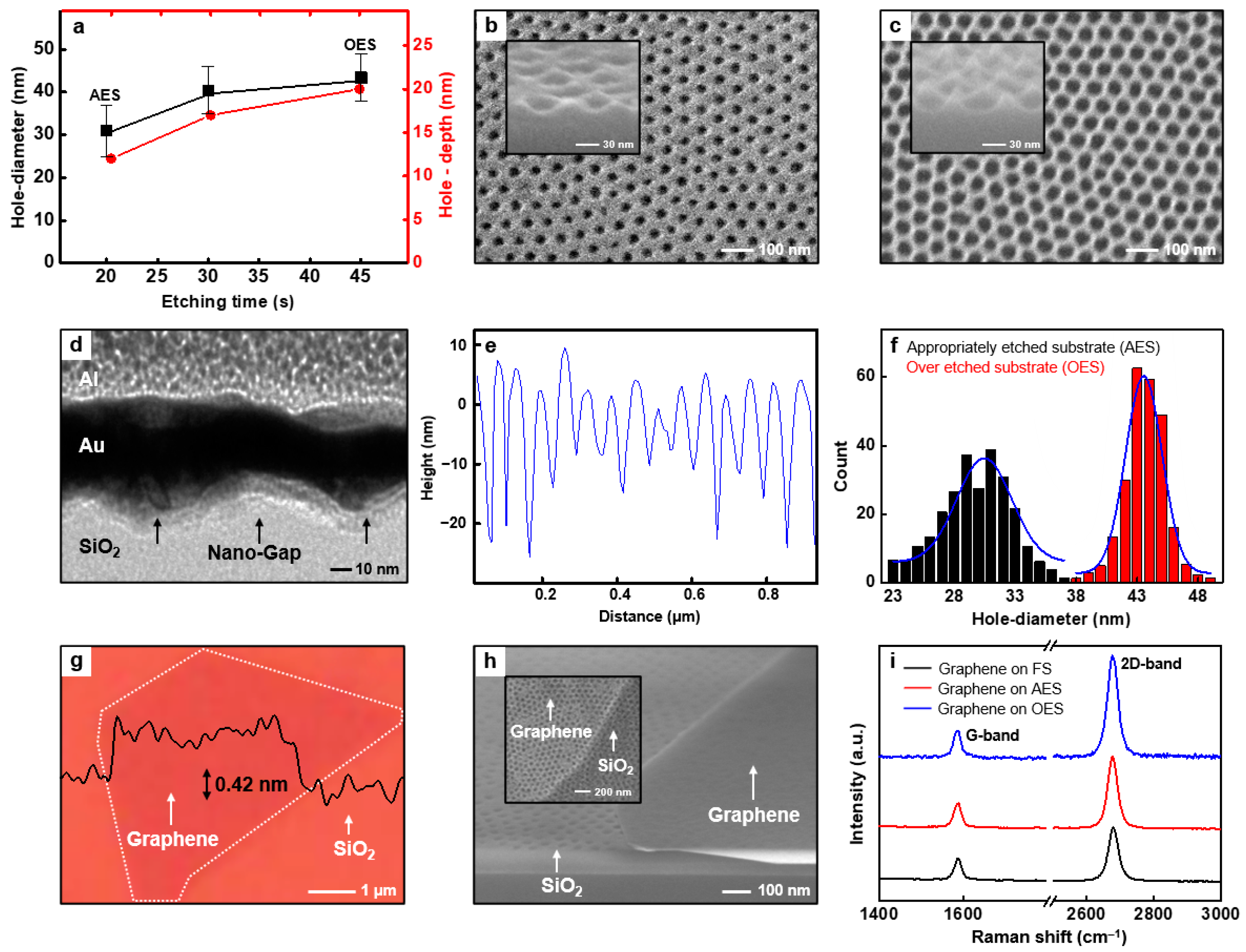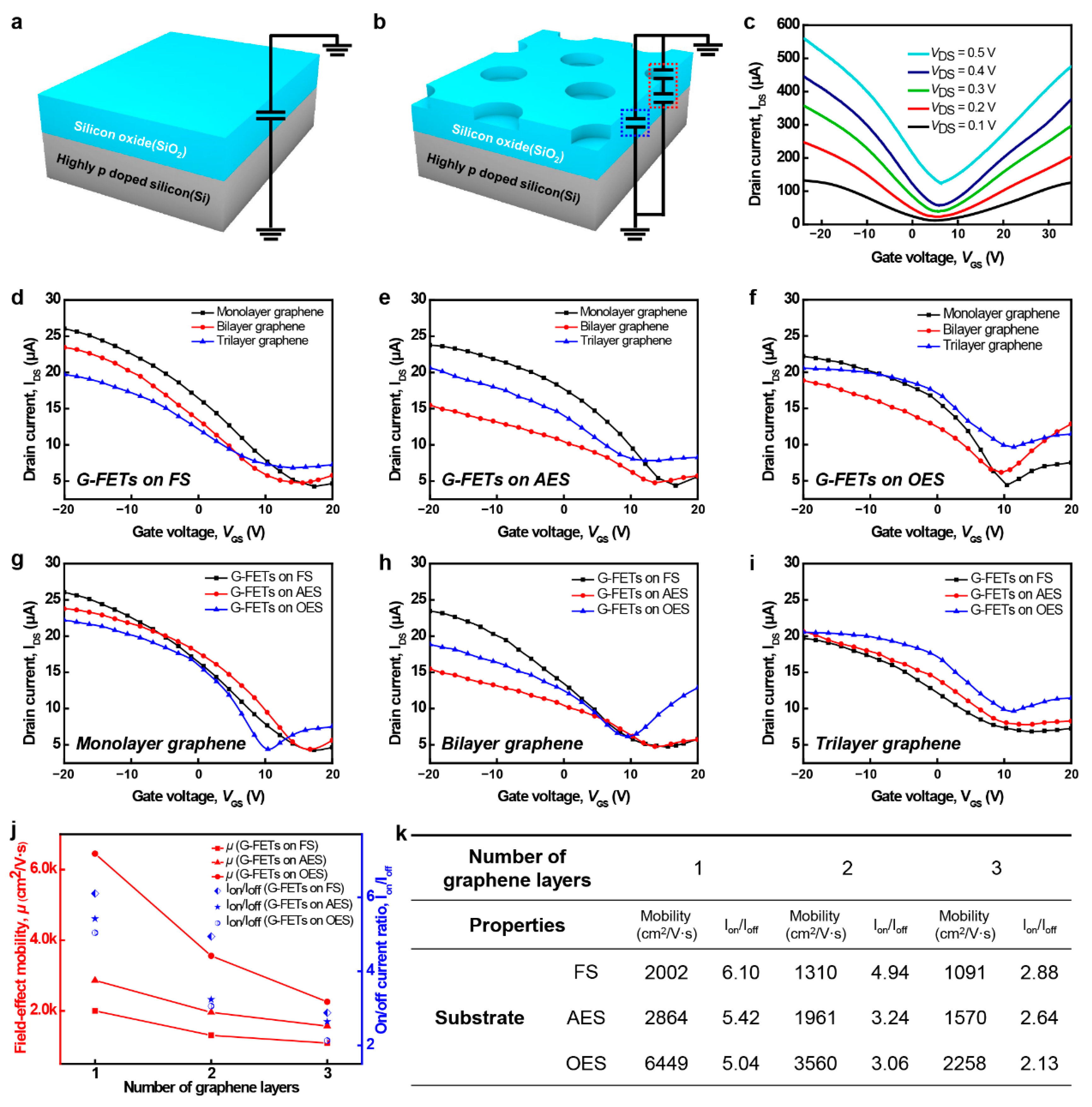High Performance Field-Effect Transistors Based on Partially Suspended 2D Materials via Block Copolymer Lithography
Abstract
:1. Introduction
2. Materials and Methods
2.1. Materials
2.2. Fabrication of Paritally Suspended G-FETs
2.2.1. Pre-Treatment of Substrate
2.2.2. BCP Self-Assembly Process
2.2.3. SiO2 Layer Etching with BCP Nanotemplates
2.2.4. Fabrication of Bottom-Contact G-FETs
2.3. Characterization
2.3.1. Surface Morphology of Nanopatterned Silicon Oxide Layer
2.3.2. Raman Spectroscopy of Graphene
2.3.3. Semiconductor Characterization System
3. Results and Discussion
3.1. Nanopatterning of Substrate Using BCP Self-Assembly
3.2. Transfer of Graphene to the Substrate and G-FETs Fabrication
3.3. Calculation of Capacitance of Insulating Layer
3.4. Analysis of G-FETs Electrical Performance
4. Conclusions
Author Contributions
Funding
Conflicts of Interest
References
- Novoselov, K.S.; Jiang, D.; Schedin, F.; Booth, T.J.; Khotkevich, V.V.; Morozov, S.V.; Geim, A.K. Two-dimensional atomic crystals. Proc. Natl. Acad. Sci. USA 2005, 102, 10451–10453. [Google Scholar] [CrossRef] [Green Version]
- Kim, K.S.; Zhao, Y.; Jang, H.; Lee, S.Y.; Kim, J.M.; Kim, K.S.; Ahn, J.-H.; Kim, P.; Choi, J.-Y.; Hong, B.H. Large-scale pat-tern growth of graphene films for stretchable transparent electrodes. Nature 2009, 457, 706–710. [Google Scholar] [CrossRef] [PubMed]
- Ohno, Y.; Maehashi, K.; Yamashiro, Y.; Matsumoto, K. Electrolyte-Gated Graphene Field-Effect Transistors for Detecting pH and Protein Adsorption. Nano Lett. 2009, 9, 3318–3322. [Google Scholar] [CrossRef] [PubMed]
- Li, L.; Yu, Y.; Ye, G.J.; Ge, Q.; Ou, X.; Wu, H.; Feng, D.; Chen, X.H.; Zhang, Y. Black phosphorus field-effect transistors. Nat. Nanotechnol. 2014, 9, 372–377. [Google Scholar] [CrossRef] [PubMed] [Green Version]
- Anasori, B.; Gogotsi, Y. 2D Metal Carbides and Nitrides (MXenes); Springer: New York, NY, USA, 2019; ISBN 978-3-030-19025-5. [Google Scholar]
- Park, S.J.; Kwon, O.S.; Lee, S.H.; Song, H.S.; Park, T.H.; Jang, J. Ultrasensitive Flexible Graphene Based Field-Effect Tran-sistor (FET)-Type Bioelectronic Nose. Nano Lett. 2012, 12, 5082–5090. [Google Scholar] [CrossRef] [PubMed]
- He, Q.; Zeng, Z.; Yin, Z.; Li, H.; Wu, S.; Huang, X.; Zhang, H. Fabrication of Flexible MoS2 Thin-Film Transistor Arrays for Practical Gas-Sensing Applications. Small 2012, 8, 2994–2999. [Google Scholar] [CrossRef] [PubMed]
- Georgiou, T.; Jalil, R.; Belle, B.D.; Britnell, L.; Gorbachev, R.V.; Morozov, S.V.; Kim, Y.-J.; Gholinia, A.; Haigh, S.J.; Makarovsky, O.; et al. Vertical field-effect transistor based on graphene–WS2 heterostructures for flexible and transparent electronics. Nat. Nanotechnol. 2013, 8, 100–103. [Google Scholar] [CrossRef]
- Lee, C.H.; Kim, D.R.; Zheng, X. Fabrication of Nanowire Electronics on Nonconventional Substrates by Water-Assisted Transfer Printing Method. Nano Lett. 2011, 11, 3435–3439. [Google Scholar] [CrossRef]
- Varchon, F.; Feng, R.; Hass, J.; Li, X.; Nguyen, B.N.; Naud, C.; Mallet, P.; Veuillen, J.-Y.; Berger, C.; Conrad, E.H.; et al. Electronic Structure of Epitaxial Graphene Layers on SiC: Effect of the Substrate. Phys. Rev. Lett. 2007, 99, 126805. [Google Scholar] [CrossRef] [Green Version]
- Wang, Y.Y.; Ni, Z.H.; Yu, T.; Shen, Z.X.; Wang, H.M.; Wu, Y.H.; Chen, W.; Shen Wee, A.T. Raman Studies of Monolayer Graphene: The Substrate Effect. J. Phys. Chem. C 2008, 112, 10637–10640. [Google Scholar] [CrossRef]
- Dean, C.R.; Young, A.F.; Meric, I.; Lee, C.; Wang, L.; Sorgenfrei, S.; Watanabe, K.; Taniguchi, T.; Kim, P.; Shepard, K.L.; et al. Boron nitride substrates for high-quality graphene electronics. Nat. Nanotechnol. 2010, 5, 722–726. [Google Scholar] [CrossRef]
- Li, Q.; Lee, C.; Carpick, R.W.; Hone, J. Substrate effect on thickness-dependent friction on graphene. Phys. Status Solidi 2010, 247, 2909–2914. [Google Scholar] [CrossRef]
- Chen, J.-H.; Jang, C.; Adam, S.; Fuhrer, M.S.; Williams, E.D.; Ishigami, M. Charged-impurity scattering in graphene. Nat. Phys. 2008, 4, 377–381. [Google Scholar] [CrossRef]
- Meyer, J.C.; Geim, A.K.; Katsnelson, M.I.; Novoselov, K.S.; Booth, T.J.; Roth, S. The structure of suspended graphene sheets. Nat. Cell Biol. 2007, 446, 60–63. [Google Scholar] [CrossRef] [PubMed]
- Bolotin, K.I.; Sikes, K.J.; Jiang, Z.; Klima, M.; Fudenberg, G.; Hone, J.; Kim, P.; Stormer, H.L. Ultrahigh electron mobility in suspended graphene. Solid State Commun. 2008, 146, 351–355. [Google Scholar] [CrossRef] [Green Version]
- Du, X.; Skachko, I.; Barker, A.; Andrei, E.Y. Approaching ballistic transport in suspended graphene. Nat. Nanotechnol. 2008, 3, 491–495. [Google Scholar] [CrossRef] [Green Version]
- Lloyd, D.; Liu, X.; Christopher, J.W.; Cantley, L.; Wadehra, A.; Kim, B.L.; Goldberg, B.B.; Swan, A.K.; Bunch, J.S. Band Gap Engineering with Ultralarge Biaxial Strains in Suspended Monolayer MoS2. Nano Lett. 2016, 16, 5836–5841. [Google Scholar] [CrossRef] [PubMed] [Green Version]
- Thiruraman, J.P.; Fujisawa, K.; Danda, G.; Das, P.M.; Zhang, T.; Bolotsky, A.; Perea-Lòpez, N.; Nicolaï, A.; Senet, P.; Terrones, M.; et al. Angstrom-Size Defect Creation and Ionic Transport through Pores in Single-Layer MoS2. Nano Lett. 2018, 18, 1651–1659. [Google Scholar] [CrossRef]
- Neri, I.; López-Suárez, M. Electronic transport modulation on suspended few-layer MoS2 under strain. Phys. Rev. B 2018, 97, 241408. [Google Scholar] [CrossRef] [Green Version]
- Hu, Y.; Kumar, P.; Xuan, Y.; Deng, B.; Qi, M.; Cheng, G.J. Controlled and Stabilized Light-Matter Interaction in Graphene: Plasmonic Film with Large-Scale 10-nm Lithography. Adv. Opt. Mater. 2016, 4, 1811–1823. [Google Scholar] [CrossRef]
- Yim, S.; Han, H.J.; Jeon, J.; Jeon, K.; Sim, D.M.; Jung, Y.S. Nanopatterned High-Frequency Supporting Structures Stably Eliminate Substrate Effects Imposed on Two-Dimensional Semiconductors. Nano Lett. 2018, 18, 2893–2902. [Google Scholar] [CrossRef]
- Kanidi, M.; Dagkli, A.; Kelaidis, N.; Palles, D.; Aminalragia-Giamini, S.; Marquez-Velasco, J.; Colli, A.; Dimoulas, A.; Li-dorikis, E.; Kandyla, M.; et al. Surface-Enhanced Raman Spectroscopy of Graphene Integrated in Plasmonic Silicon Plat-forms with Three-Dimensional Nanotopography. J. Phys. Chem. C 2019, 123, 3076–3087. [Google Scholar] [CrossRef] [Green Version]
- Chaste, J.; Hnid, I.; Khalil, L.; Si, C.; Durnez, A.; Lafosse, X.; Zhao, M.-Q.; Johnson, A.T.C.; Zhang, S.; Bang, J.; et al. Phase Transition in a Memristive Suspended MoS2 Monolayer Probed by Opto- and Electro-Mechanics. ACS Nano 2020, 14, 13611–13618. [Google Scholar] [CrossRef]
- Kaushik, N.; Ghosh, S.; Lodha, S. Low-Frequency Noise in Supported and Suspended MoS2 Transistors. IEEE Trans. Electron Devices 2018, 65, 4135–4140. [Google Scholar] [CrossRef]
- Kim, B.H.; Park, S.J.; Jin, H.M.; Kim, J.Y.; Son, S.-W.; Kim, M.-H.; Koo, C.M.; Shin, J.; Kim, J.U.; Kim, S.O. Anomalous Rapid Defect Annihilation in Self-Assembled Nanopatterns by Defect Melting. Nano Lett. 2015, 15, 1190–1196. [Google Scholar] [CrossRef] [PubMed]
- Kim, S.O.; Solak, H.H.; Stoykovich, M.P.; Ferrier, N.J.; de Pablo, J.J.; Nealey, P.F. Epitaxial self-assembly of block copoly-mers on lithographically defined nanopatterned substrates. Nature 2003, 424, 411–414. [Google Scholar] [CrossRef] [PubMed]
- Kim, B.H.; Kim, J.Y.; Kim, S.O. Directed self-assembly of block copolymers for universal nanopatterning. Soft Matter 2013, 9, 2780. [Google Scholar] [CrossRef]
- Kim, B.H.; Kim, J.Y.; Jeong, S.-J.; Hwang, J.O.; Lee, D.H.; Shin, D.O.; Choi, S.-Y.; Kim, S.O. Surface Energy Modification by Spin-Cast, Large-Area Graphene Film for Block Copolymer Lithography. ACS Nano 2010, 4, 5464–5470. [Google Scholar] [CrossRef]
- Novoselov, K.S.; Geim, A.K.; Morozov, S.V.; Jiang, D.; Zhang, Y.; Dubonos, S.V.; Grigorieva, I.V.; Firsov, A.A. Electric Field Effect in Atomically Thin Carbon Films. Science 2004, 306, 666–669. [Google Scholar] [CrossRef] [Green Version]
- Kim, B.H.; Byeon, K.-J.; Kim, J.Y.; Kim, J.; Jin, H.M.; Cho, J.-Y.; Jeong, S.-J.; Shin, J.; Lee, H.; Kim, S.O. Negative-Tone Block Copolymer Lithography by In Situ Surface Chemical Modification. Small 2014, 10, 4207–4212. [Google Scholar] [CrossRef] [PubMed]
- Kim, B.H.; Choi, Y.; Kim, J.Y.; Shin, H.; Kim, S.; Son, S.-W.; Kim, S.O.; Kim, P. Wrinkle-Directed Self-Assembly of Block Copolymers for Aligning of Nanowire Arrays. Adv. Mater. 2014, 26, 4665–4670. [Google Scholar] [CrossRef]
- Kim, J.Y.; Kim, H.; Kim, B.H.; Chang, T.; Lim, J.; Jin, H.M.; Mun, J.H.; Choi, Y.J.; Chung, K.; Shin, J.; et al. Highly tunable refractive index visible-light metasurface from block copolymer self-assembly. Nat. Commun. 2016, 7, 12911. [Google Scholar] [CrossRef] [Green Version]
- Kim, B.H.; Koo, C.M.; Shin, D.O.; Jeong, S.J.; Kim, S.O. The Synthesis of Random Brush for Nanostructure of Block Co-polymer. Macromol. Symp. 2007, 249, 303–306. [Google Scholar] [CrossRef]
- Kim, B.H.; Lee, H.M.; Lee, J.-H.; Son, S.-W.; Jeong, S.-J.; Lee, S.; Lee, D.I.; Kwak, S.U.; Jeong, H.; Shin, H.; et al. Spontaneous Lamellar Alignment in Thickness-Modulated Block Copolymer Films. Adv. Funct. Mater. 2009, 19, 2584–2591. [Google Scholar] [CrossRef]
- Gu, X.; Gunkel, I.; Russell, T.P. Pattern transfer using block copolymers. Philos. Trans. R. Soc. A Math. Phys. Eng. Sci. 2013, 371, 20120306. [Google Scholar] [CrossRef] [Green Version]
- Kim, B.H.; Koo, C.M.; Jeong, S.-J.; Shin, D.O.; Kim, S.O. Self-Assembled Nanostructures of Block Copolymers on Random Copolymer Brush. Solid State Phenom. 2007, 124, 579–582. [Google Scholar] [CrossRef]
- Kim, B.H.; Lee, D.H.; Kim, J.Y.; Shin, D.O.; Jeong, H.Y.; Hong, S.; Yun, J.M.; Koo, C.M.; Lee, H.; Kim, S.O. Mussel-Inspired Block Copolymer Lithography for Low Surface Energy Materials of Teflon, Graphene, and Gold. Adv. Mater. 2011, 23, 5618–5622. [Google Scholar] [CrossRef]
- Oh, S.J.; Uswachoke, C.; Zhao, T.; Choi, J.-H.; Diroll, B.T.; Murray, C.B.; Kagan, C.R. Selective p- and n-Doping of Col-loidal PbSe Nanowires To Construct Electronic and Optoelectronic Devices. ACS Nano 2015, 9, 7536–7544. [Google Scholar] [CrossRef] [PubMed]
- Das, A.; Pisana, S.; Chakraborty, B.; Piscanec, S.; Saha, S.K.; Waghmare, U.V.; Novoselov, K.S.; Krishnamurthy, H.R.; Geim, A.K.; Ferrari, A.C.; et al. Monitoring dopants by Raman scattering in an electrochemically top-gated graphene transistor. Nat. Nanotechnol. 2008, 3, 210–215. [Google Scholar] [CrossRef] [PubMed] [Green Version]
- Lin, Y.; Chiu, H.; Jenkins, K.A.; Farmer, D.B.; Avouris, P.; Valdes-Garcia, A. Dual-Gate Graphene FETs With fT of 50 GHz. IEEE Electron Device Lett. 2009, 31, 68–70. [Google Scholar] [CrossRef] [Green Version]
- Chen, J.-H.; Jang, C.; Xiao, S.; Ishigami, M.; Fuhrer, M.S. Intrinsic and extrinsic performance limits of graphene devices on SiO2. Nat. Nanotechnol. 2008, 3, 206–209. [Google Scholar] [CrossRef] [PubMed]
- Kang, Y.-J.; Kang, J.; Chang, K.J. Electronic structure of graphene and doping effect on SiO2. Phys. Rev. B 2008, 78, 115404. [Google Scholar] [CrossRef] [Green Version]
- Kim, J.Y.; Kim, J.; Kang, S.H.; Shin, D.O.; Lee, M.J.; Oh, J.; Lee, Y.-G.; Kim, K.M. Efficient cell design and fabrication of concentration-gradient composite electrodes for high-power and high-energy-density all-solid-state batteries. ETRI J. 2020, 42, 129–137. [Google Scholar] [CrossRef] [Green Version]




Publisher’s Note: MDPI stays neutral with regard to jurisdictional claims in published maps and institutional affiliations. |
© 2021 by the authors. Licensee MDPI, Basel, Switzerland. This article is an open access article distributed under the terms and conditions of the Creative Commons Attribution (CC BY) license (http://creativecommons.org/licenses/by/4.0/).
Share and Cite
Kim, S.; Lee, S.E.; Park, J.H.; Shin, J.Y.; Lee, B.; Lim, H.Y.; Oh, Y.T.; Hwang, J.P.; Seon, S.W.; Kim, S.H.; et al. High Performance Field-Effect Transistors Based on Partially Suspended 2D Materials via Block Copolymer Lithography. Polymers 2021, 13, 566. https://doi.org/10.3390/polym13040566
Kim S, Lee SE, Park JH, Shin JY, Lee B, Lim HY, Oh YT, Hwang JP, Seon SW, Kim SH, et al. High Performance Field-Effect Transistors Based on Partially Suspended 2D Materials via Block Copolymer Lithography. Polymers. 2021; 13(4):566. https://doi.org/10.3390/polym13040566
Chicago/Turabian StyleKim, Simon, Su Eon Lee, Jun Hyun Park, Jin Yong Shin, Bom Lee, Heo Yeon Lim, Young Taek Oh, Jun Pyo Hwang, Seung Won Seon, Seung Hee Kim, and et al. 2021. "High Performance Field-Effect Transistors Based on Partially Suspended 2D Materials via Block Copolymer Lithography" Polymers 13, no. 4: 566. https://doi.org/10.3390/polym13040566






